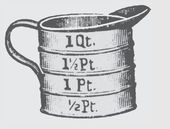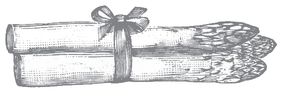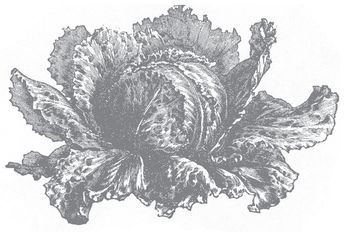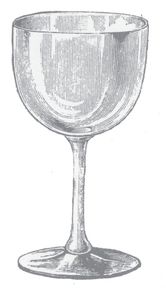Food Rules (7 page)
Authors: Michael Pollan


41
Eat more like the French. Or the Japanese. Or the Italians. Or the Greeks.
People who eat according to the rules of a traditional food culture are generally healthier than those of us eating a modern Western diet of processed foods. Any traditional diet will do: If it were not a healthy diet, the people who follow it wouldn’t still be around. True, food cultures are embedded in societies and economies and ecologies, and some of them travel better than others, Inuit not so well as Italian. In borrowing from a food culture, pay attention to
how
a culture eats as well as to what it eats. In the case of the French paradox, for example, it may not be the dietary nutrients that keep the French healthy (lots of saturated fat and white flour?!) as much as their food habits: small portions eaten at leisurely communal meals; no second helpings or snacking. Pay attention, too, to the combinations of foods in traditional cultures: In Latin America, corn is traditionally cooked with lime and eaten with beans; what would otherwise be a nutritionally deficient staple becomes the basis of a healthy, balanced diet. (The beans supply amino acids lacking in corn, and the lime makes niacin available.) Cultures that took corn from Latin America without the beans or the lime wound up with serious nutritional deficiencies such as pellagra. Traditional diets are more than the sum of their food parts.
how
a culture eats as well as to what it eats. In the case of the French paradox, for example, it may not be the dietary nutrients that keep the French healthy (lots of saturated fat and white flour?!) as much as their food habits: small portions eaten at leisurely communal meals; no second helpings or snacking. Pay attention, too, to the combinations of foods in traditional cultures: In Latin America, corn is traditionally cooked with lime and eaten with beans; what would otherwise be a nutritionally deficient staple becomes the basis of a healthy, balanced diet. (The beans supply amino acids lacking in corn, and the lime makes niacin available.) Cultures that took corn from Latin America without the beans or the lime wound up with serious nutritional deficiencies such as pellagra. Traditional diets are more than the sum of their food parts.
42
Regard nontraditional foods with skepticism.
Innovation is always interesting, but when it comes to food, it pays to approach new creations with caution. If diets are the products of an evolutionary process in which groups of people adapt to the plants, animals, and fungi a particular place has to offer, then a novel food or culinary innovation resembles a mutation: It
might
represent an evolutionary improvement, but chances are it doesn’t. Soy products offer a good case in point. People have been eating soy in the form of tofu, soy sauce, and tempeh for many generations, but today we’re eating novelties like “soy protein isolate,” “soy isoflavones,” and “textured vegetable protein” from soy and partially hydrogenated soy oils, and there are questions about the healthfulness of these new food products. As a senior FDA scientist has written, “Confidence that soy products are safe is clearly based more on belief than hard data.”
3
Until we have that data, you’re probably better off eating soy prepared in the traditional Asian manner than according to the novel recipes dreamed up by food scientists.
might
represent an evolutionary improvement, but chances are it doesn’t. Soy products offer a good case in point. People have been eating soy in the form of tofu, soy sauce, and tempeh for many generations, but today we’re eating novelties like “soy protein isolate,” “soy isoflavones,” and “textured vegetable protein” from soy and partially hydrogenated soy oils, and there are questions about the healthfulness of these new food products. As a senior FDA scientist has written, “Confidence that soy products are safe is clearly based more on belief than hard data.”
3
Until we have that data, you’re probably better off eating soy prepared in the traditional Asian manner than according to the novel recipes dreamed up by food scientists.
43
Have a glass of wine with dinner.
Wine may not be the magic bullet in the French or Mediterranean diet, but it does seem to be an integral part of these dietary patterns. There is now considerable scientific evidence for the health benefits of alcohol to go with a few centuries of traditional belief and anecdotal evidence. Mindful of the social and health effects of alcoholism, public health authorities are loath to recommend drinking, but the fact is that people who drink moderately and regularly live longer and suffer considerably less heart disease than teetotalers. Alcohol of any kind appears to reduce the risk of heart disease, but the polyphenols in red wine (resveratrol in particular) may have unique protective qualities. Most experts recommend no more than two drinks a day for men, one for women. Also, the health benefits of alcohol may depend as much on the pattern of drinking as on the amount: Drinking a little every day is better than drinking a lot on the weekends, and drinking with food is better than drinking without it. Someday science may figure out the complex synergies at work in a traditional diet that includes wine, but until then we can marvel at its accumulated wisdom—and raise a glass to paradox.
PART III
How should I eat?

(Not too much.)
The rules in the previous two sections deal primarily with questions about what to eat; the ones in this section deal with something a bit more elusive but no less important: the set of manners, eating habits, taboos, and unspoken guidelines that together govern a person’s (and a culture’s) relationship to food and eating.
How
you eat may have as much bearing on your health (and your weight) as
what
you eat.
How
you eat may have as much bearing on your health (and your weight) as
what
you eat.
This may well be the deeper lesson of the so-called French paradox: the mystery (at least to nutritionists) of a population that eats all sorts of supposedly lethal fatty foods, and washes them down with red wine, but which is nevertheless healthier, slimmer, and slightly longer lived than we are. What nutritionists fail to see in the French is a people with a completely different relationship to food than we have. They seldom snack, eat small portions from small plates, don’t go back for second helpings, and eat most of their food at long, leisurely meals shared with other people. The rules governing these behaviors may matter more than any magic nutrient in their diet.
The rules in this section are designed to foster a healthier relationship to food, whatever it is you’re eating.

44
Pay more, eat less.
With food, as with so many things, you get what you pay for. There is also a trade-off b etween quality and quantity, and a person’s “food experience”—a meal’s duration or quotient of p leasure—does not necessarily correlate with the number of calories consumed. The American food system has for many years devoted its energies to increasing q uantity and reducing price rather than to improving q uality. There’s no escaping the fact that better food—measured by taste or nutritional quality (which often correspond)—costs more, because it has been grown or raised less intensively and with more care. Not everyone can afford to eat well in America, which is a literal shame, but most of us can: Americans spend less than 10 percent of their income on food, less than the citizens of any other nation. As the cost of food in America has declined, in terms of both price and the effort required to put it on the table, we have been eating much more (and spending more on health care). If you spend more for better food, you’ll probably eat less of it, and treat it with more care. And if that higher-quality food tastes better, you will need less of it to feel satisfied. Choose quality over quantity, food experience over mere calories. Or as grandmothers used to say, “Better to pay the grocer than the doctor.”
45
. . . Eat less.
This is probably the most unwelcome advice of all, but in fact the scientific case for eating a lot less than we currently do—regardless of whether you are overweight—is compelling. “Calorie restriction” has repeatedly been shown to slow aging in animals, and many researchers believe it offers the single strongest link between diet and cancer prevention. We eat much more than our bodies need to be healthy, and the excess wreaks havoc—and not just on our weight. But we are not the first people in history to grapple with the special challenges posed by food abundance, and previous cultures have devised various ways to promote the idea of moderation. The rules that follow offer a few proven strategies.

46
Stop eating before you’re full.
Nowadays we think it is normal and right to eat until you are full, but many cultures specifically advise stopping well before that point is reached. The Japanese have a saying—
hara hachi bu
—counseling people to stop eating when they are 80 percent full. The Ayurvedic tradition in India advises eating until you are 75 percent full; the Chinese specify 70 percent, and the prophet Muhammad described a full belly as one that contained ⅓ food and ⅓ liquid—and ⅓ air, i.e., nothing. (Note the relatively narrow range specified in all this advice: somewhere between 67 and 80 percent of capacity. Take your pick.) There’s also a German expression that says: “You need to tie off the sack before it gets completely full.” And how many of us have grand-parents who talk of “leaving the table a little bit hungry”? Here again the French may have something to teach us. To say “I’m hungry” in French you say “J’ai faim”—“I have hunger”—and when you are finished, you do not say that you are full, but “Je n’ai plus faim”—“I have no more hunger.” That is a completely different way of thinking about satiety. So: Ask yourself not, Am I full? but, Is my hunger gone? That moment will arrive several bites sooner.
hara hachi bu
—counseling people to stop eating when they are 80 percent full. The Ayurvedic tradition in India advises eating until you are 75 percent full; the Chinese specify 70 percent, and the prophet Muhammad described a full belly as one that contained ⅓ food and ⅓ liquid—and ⅓ air, i.e., nothing. (Note the relatively narrow range specified in all this advice: somewhere between 67 and 80 percent of capacity. Take your pick.) There’s also a German expression that says: “You need to tie off the sack before it gets completely full.” And how many of us have grand-parents who talk of “leaving the table a little bit hungry”? Here again the French may have something to teach us. To say “I’m hungry” in French you say “J’ai faim”—“I have hunger”—and when you are finished, you do not say that you are full, but “Je n’ai plus faim”—“I have no more hunger.” That is a completely different way of thinking about satiety. So: Ask yourself not, Am I full? but, Is my hunger gone? That moment will arrive several bites sooner.
47
Eat when you are hungry, not when you are bored.
For many of us, eating has surprisingly little to do with hunger. We eat out of boredom, for entertainment, to comfort or reward ourselves. Try to be aware of
why
you’re eating, and ask yourself if you’re really hungry—before you eat and then again along the way. (One old wives’ test: If you’re not hungry enough to eat an apple, then you’re not hungry.) Food is a costly antidepressant.
why
you’re eating, and ask yourself if you’re really hungry—before you eat and then again along the way. (One old wives’ test: If you’re not hungry enough to eat an apple, then you’re not hungry.) Food is a costly antidepressant.

48
Consult your gut.
Most of us allow external, and usually visual, cues to determine how much we eat. The larger the portion, for example, the more we eat; the bigger the container, the more we pour. As in so many areas of modern life, the culture of food has become a culture of the eye. But when it comes to food, it pays to cultivate the other senses, which often provide more useful and accurate information. It can take twenty minutes before your brain gets the word that your belly is full; that means that if you take less than twenty minutes to finish a meal, the sensation of satiety will arrive too late to be of any use. So slow down and pay attention to what your body—and not just your sense of sight—is telling you. This is what your grand-parents were getting at with the adage “Your eyes are bigger than your stomach.”
Other books
The Caravan Road by Jeffrey Quyle
Lucca by Karen Michelle Nutt
Moron by Todd Millar
Sarah’s Billionaire Doms by Angelique Voisen
Criminal Conversation by Nicolas Freeling
Fighting for Love by L.P. Dover
Heresy: A Catherine LeVendeur Mystery by Newman, Sharan
A Closed Eye by Anita Brookner
A Noble Estate by A.C. Ellas
The Price of Malice by Archer Mayor